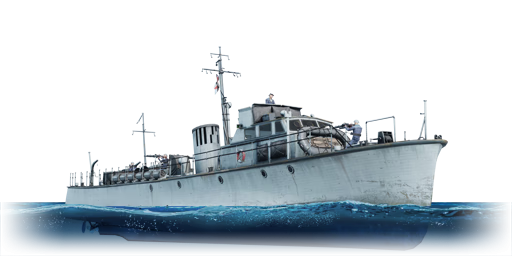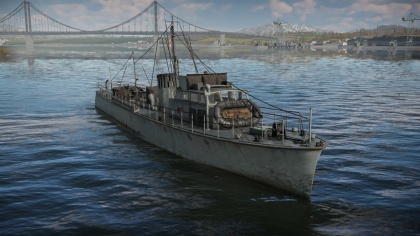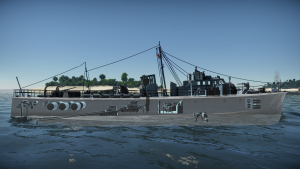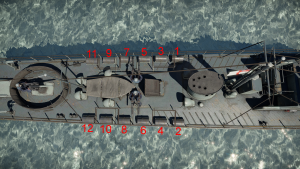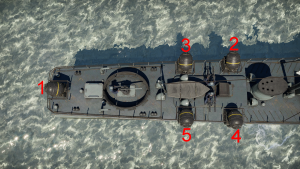Difference between revisions of "Fairmile A (ML100)"
m (→Secondary armament: typo) |
m (→Special armament: typo) |
||
| Line 155: | Line 155: | ||
[[File:{{PAGENAME}}_DC_Order.png|thumb|Mk.VII depth charges numbered according to their drop order (click to view a larger image).]] | [[File:{{PAGENAME}}_DC_Order.png|thumb|Mk.VII depth charges numbered according to their drop order (click to view a larger image).]] | ||
| − | {{PAGENAME}} has | + | {{PAGENAME}} has three possible loadouts: |
# 12x Mk.VII depth charge | # 12x Mk.VII depth charge | ||
Revision as of 14:59, 20 October 2020
Contents
Description
The Fairmile A (ML100) is a rank I British motor gun boat
with a battle rating of 1.0 (AB/RB/SB). It was introduced in Update 1.83 "Masters of the Sea" as part of the British fleet closed beta test.
General info
Survivability and armour
Fairmile A (ML100) has the following armour layout:
- Hull: 24 mm, wood
- Superstructure: 2 mm, steel
Any gun in the game will easily be able to penetrate the hull and superstructure at any practical range.
Fairmile A (ML100) can be hull-broken by any gun that is greater than 4 inches (102 mm) in diameter. Hull-break is triggered when any such gun hits and destroys any hull compartment — or in some cases, the bridge — with a high-explosive round, upon which the rest of the boat will be destroyed. At Fairmile A (ML100)'s battle rating, there is only one gun capable of hull-breaking her:
- the 8cwt QF Mk I, found on Dark Adventurer.
Fairmile A (ML100)'s hull is split into four compartments. The first compartment starts at the bow and ends in the middle of the bridge, just in front of the pumps; the second ends just between the radio station and the engines, around the funnel; the third ends in front of the aft gun mount; and the fourth ends at the stern.
Fairmile A (ML100) has two ammunition storages. One is located in the bow below the fore twin 7.72 mm Lewis 1916 machinegun mount and holds the ammunition for all three Lewis 1916 machinegun mounts. The other ammunition storage is located in the stern on the port side, below and behind the aft 3 pdr QF Hotchkiss cannon, and holds the ammunition for the 3 pdr cannon. Both ammunition storages are located above the waterline and destroying either will instantly destroy the boat.
With a crew complement of 14, Fairmile A (ML100)'s overall survivability is average.
Mobility
| Mobility Characteristics | |||||
|---|---|---|---|---|---|
| Game Mode | Upgrade Status | Maximum Speed (km/h) | Turn Time (s) | Turn Radius (m) | |
| Forward | Reverse | ||||
| AB | Stock | 46 | 14 | ~40.88 | ~61.45 |
| Upgraded | 62 | 19 | ~26.99 | ~39.38 | |
| RB/SB | Stock | 40 | 12 | ~47.12 | ~70.83 |
| Upgraded | 46 | 14 | ~37.33 | ~56.11 | |
Fairmile A (ML100) has a displacement of 57 tons.
Armament
Primary armament
The primary armament consists of a single 47 mm 3 pdr QF Hotchkiss cannon mounted aft. There are 300 rounds of ammunition available for it. Stock, the mount can traverse horizontally at a rate of 34°/s and vertically at a rate of 21°/s; with the "Primary Armament Targeting" modification installed, this is increased to 40°/s and 25°/s respectively. The gun is single-shot with a nominal rate of fire of 30 rounds/min. With a stock crew, it can be reloaded in 2.6 seconds; with an aced crew, it can be reloaded in 2 seconds.
| Primary Armament Guidance | |
|---|---|
| Horizontal | Vertical |
| ±180° | -5°/+25° |
There is only one ammunition choice available:
- 3 pdr Mk.2 HE
| Penetration Statistics | |||||||
|---|---|---|---|---|---|---|---|
| Ammunition | Type of warhead |
Penetration @ 0° Angle of Attack (mm) | |||||
| 100 m | 1,000 m | 2,000 m | 3,000 m | 4,000 m | 5,000 m | ||
| 3 pdr Mk.2 HE | HE | 4 | 4 | 4 | 4 | 4 | 4 |
| Shell Details | |||||||||
|---|---|---|---|---|---|---|---|---|---|
| Ammunition | Type of warhead |
Velocity (m/s) |
Projectile Mass (kg) |
Fuse delay (m) |
Fuse sensitivity (mm) |
Explosive Mass (TNT equivalent) (g) |
Ricochet | ||
| 0% | 50% | 100% | |||||||
| 3 pdr Mk.2 HE | HE | 571 | 1.5 | 0 | 0.1 | 132 | 79° | 80° | 81° |
Secondary armament
The secondary armament consists of six 7.72 mm Lewis 1916 machineguns in three twin mounts with one mount on the bow and two amidships. There are 3,880 rounds of ammunition available for each mount, 1,940 rounds per gun, for a total of 11,640 rounds. Stock, the mounts can traverse horizontally at a rate of 64°/s and vertically at a rate of 55°/s; with the "Auxiliary Armament Targeting" modification installed, this is increased to 75°/s and 65°/s respectively. Each gun has a magazine capacity of 97 rounds and a rate of fire of 550 rounds/min. With a stock crew, the guns can be reloaded in 14 seconds; with an aced crew, they can be reloaded in 7 seconds.
| Turrets are named sequentially, clockwise, starting at the bow |
| Secondary Armament Guidance | |||||
|---|---|---|---|---|---|
| No.1 Turret (fore) | No.2 Turret (starboard) | No.3 Turret (port) | |||
| Horizontal | Vertical | Horizontal | Vertical | Horizontal | Vertical |
| ±180° | -5°/+70° | ±80° | -5°/+70° | ±80° | -5°/+70° |
There are three ammunition choices available:
- Universal: AP · T · AP · T
- 7.7 mm AP belt: AP · AP · AP · T
- 7.7 mm API belt: IT · IT · IT · AP
| Penetration Statistics | ||||||
|---|---|---|---|---|---|---|
| Ammunition | Penetration @ 0° Angle of Attack (mm) | |||||
| 10 m | 100 m | 500 m | 1,000 m | 1,500 m | 2,000 m | |
| Universal | 10 | 9 | 8 | 7 | 6 | 5 |
| 7.7 mm AP belt | 10 | 9 | 8 | 7 | 6 | 5 |
| 7.7 mm API belt | 10 | 9 | 8 | 7 | 6 | 5 |
Special armament
Fairmile A (ML100) has three possible loadouts:
- 12x Mk.VII depth charge
- 5x Type M Mk I mines
- Without load
The Mk.VII depth charges are carried in racks amidships, six on each side, between the funnel and the aft gun mount. They are dropped in the following order (see the image): fore to aft alternating port and starboard, starting at the foremost depth charge on the port side.
Before spawning, the detonation time delay can be set anywhere between 3 seconds and 10 seconds.
| Depth Charge Characteristics | |||
|---|---|---|---|
| Mass (kg) | Explosive Type | Explosive Mass (kg) | TNT Equivalent (kg) |
| 196 | TNT | 130 | 130 |
The Type M Mk I mines are carried one on the stern and four amidships, two on each side, between the funnel and the aft gun mount. They are dropped in the following order:
- Stern
- Port, foremost
- Port, aftmost
- Starboard, foremost
- Starboard, aftmost
| Mine Characteristics | |||
|---|---|---|---|
| Mass (kg) | Explosive Type | Explosive Mass (kg) | TNT Equivalent (kg) |
| 600 | TNT | 227 | 227 |
Usage in battles
Fairmile A (ML100)'s primary armament — a single 3 pdr QF Hotchkiss cannon — is rather poor. It's a single-shot cannon and is fairly average compared to similar weapons. However, all single-shot cannons at this calibre have incredibly poor damage output and will be outperformed by almost any automatic weapon. The gun's accuracy also is unreliable, and the muzzle velocity is low enough to make accurately hitting moving targets beyond about 1.5 km impracticle. Additionally, the gun is mounted on the stern which only further reduces its versatility. The secondary armament doesn't fair much better either. Because of their arrangement, only two of the four twin mounts can be brought to bear at once. This essentially limits Fairmile A (ML100) to only half that of MTB-1(1), whose armament wasn't very outstanding to begin with. Like the 3 pdr QF Hotchkiss, the 7.72 mm Lewis 1916 machineguns are themselves plagued by poor damage output and a low maximum range. With four of them altogether though, their damage output ends up being better than the 3 pdr cannon, so primarily use the machineguns and only switch to the cannon if they get knocked out.
Because of the bad damage output, Fairmile A (ML100) will feel much less survivable compared to other vehicles in the tech tree, despite actually having a larger crew. Ironically, the greatest determining factor of a vehicle's survivability is actually its firepower, rather than any direct defensive quality. Fairmile A (ML100) is simply unable to destroy enemies as quickly as others and will naturally be subject to enemy fire for longer periods of time. Because of this, it is especially important to maximize damage output when playing Fairmile A (ML100). Only fire when you know the shots will land and always fire off any remaining ammunition after engagements; this ensures that you have full magazines at the start of the next engagement. The machinegun reloads are quite long, so running out of ammunition in the middle of an engagement is often a death sentence.
Like MTB-1 1 series and anything armed with low-calibre machineguns, Fairmile A (ML100) is best played at close ranges to negate the guns' range disadvantage. Unlike those vehicles though, Fairmile A (ML100) lacks the survivability and firepower necessary to stay on the front line, so try to stay on the sidelines and make use of cover as much as possible. From here, play an assist role by ambushing enemies distracted by your teammates. However, only fire at enemies you know you can take out to avoid drawing any unnecessary attention to yourself. As an example, any vehicle with armour will be unaffected by both the machineguns and the cannon, so against such opponents, as long as they don't notice you, it's best to just mark them on the map for your team, call artillery, then simply let them pass.
- Ammunition
The best ammunition choice is the 7.7 mm AP belt since it has the highest ratio of AP to T rounds. While the 7.7 mm API belt may look tempting because of the incendiary tracer rounds and lack of tracer rounds, the IT rounds can actually be stopped by some wooden hulls and almost all metal hulls. Additionally, their damage output is closer to that of the standard tracer round than the AP round, and they rarely start fires, if ever. While the IT rounds are technically the best against aircraft, with such a long reload time to switch to the API belt and with barely any noticeable difference, there's really no point in using the API belt for that either. Take only the AP belt.
- Depth Charges
There is no practical reason to use depth charges on any naval vessel in the game. Although they usually result in a one-hit kill if used properly, they are extremely situational and are actually a liability in most cases. This is because they essentially act as exposed ammo racks before they're dropped.
With some luck, sailing up right next to a slower target and dropping a depth charge can lead to some success. If attempting this, remember the depth charge drop order and know that there is no reason to set the depth charge delay above the minimum 3 seconds, since a higher delay time means that the depth charge will only sink further, and thus away, from the target. Again, this is extremely situational.
- Mines
Like depth charges, naval mines are situational weapons that act like exposed ammunition racks if not dropped. Still, they are vastly more useful than depth charges. With mines, Fairmile A (ML100) can play a utility role by using the mines to cut off narrow passageways and block capture points, then returning back to a friendly capture to reload before repeating. This playstyle is still very situational though, as it requires misplay on the enemy's part. An adept player will destroy the mines with gunfire or simply sail around them. Mines will also despawn after some period of time, so complete coverage of all routes will never be possible. Additionally, this playstyle forces Fairmile A (ML100) to the front lines, which is undesirable due to her poor armament.
Lastly, it should be also be mentioned that, in a pinch, the mines can essentially be used as a better depth charge as described above, since they have no time delay and have a much larger explosive charge. If using them like this, remember the drop order; it is not the same as the depth charge drop order. All said, mines are still a situational weapon, so take them or don't based on personal preference.
The recommended loadouts are, depending on personal preference:
- 5x Type M Mk I mines; or
- Without load
Modules
| Tier | Seakeeping | Unsinkability | Firepower | |||
|---|---|---|---|---|---|---|
| I | Dry-Docking | Tool Set | 7.7 mm AP belt | |||
| II | Rudder Replacement | Fire Protection System | Smokescreen | 7.7 mm API belt | Auxiliary Armament Targeting | |
| III | Propeller Replacement | Depth Charges | Primary Armament Targeting | Improved Rangefinder | ||
| IV | Engine Maintenance | New Pumps | Artillery Support | Mines | ||
Pros and cons
Pros:
- Access to mines
Cons:
- Very weak armament
- Primary armament has poor accuracy
- Can only bring 4 secondary guns on target at once
- Cannot effectively fight armoured targets
- Poor survivability
- Below-average top speed and manoeuvrability
History
In early 1939, Noel Macklin, a British industrialist, became aware of the Royal Navy's lack of anti-submarine boats through an article by Vice-Admiral Cecil Vivian Usborne. Macklin formulated a scheme in which prefabricated parts, built as near to completion as possible, would be sent in kit form ready for final assembly and fitting to the many minor boatbuilding companies throughout the country. This would allow parts and materials to be sourced from companies with no boatbuilding experience and assembled by unskilled labour at unutilized boatyards. Under this decentralized system, the boats could be manufactured quicker and cheaper than had they been manufactured at a single yard, all the while without straining major boatbuilding companies, such as Vospers, British Power Boat Co., White, or Thorycroft, which were needed to produce specialized, high-speed MTBs and MGBs. Macklin met with Vice-Admiral Usborne in May 1939, and immediately, they began assembling a team of naval engineers and designers and shortly thereafter formed the Fairmile Marine Company. Fairmile quickly produced a wooden motor launch design and proposed the idea to the Admiralty. Ultimately, the Admiralty declined to make an order. Nevertheless, convinced in the idea, Fairmile proceeded to produce a prototype as a private venture.
The prototype was ordered from Woodnutt & Co. at St Helens, Isle of Wight, on 27th July 1939 and was laid down on 29th October 1939. It had a hard chine hull and had a length overall of 110 ft, a beam of 17 ft 5 in, a draught of 4 ft 6 in, and a displacement of around 57 tons. It was powered by three Hall-Scott Defender petrol engines, each producing 600 bhp each, allowing it to achieve a top speed of 25 knots. With the prospect of war approaching ever closer, the Admiralty had no choice but to acknowledge the serious submarine threat and reconsidered Macklin's proposal. While the prototype was still under construction, the Admiralty purchased in the summer of 1939. This order was followed by another on 22nd September 1939 for an additional 24 boats, though this was later revised to 11 Fairmile designs — the Fairmile A type — and 13 boats of a new Admiralty design — the Fairmile B type. The twelve Fairmile A motor launches were built by ten different companies and were all be completed between May and June 1940, all twelve entering service shortly after completion as MLs 100-111.
Interestingly, the Fairmile A motor launches were ordered by the Admiralty without a specified armament. As such, the decks of the boats were not built to take heavy mounting equipment. As a stopgap measure, it was decided that they should be armed with a single aft QF 3-pdr Hotchkiss cannon and several twin Lewis gun pintle mounts, with one on the bow and a pair of mounts amidships. For hunting U-boats, the boats were given ASDIC equipment and depth charge racks, one on each side, capable of carrying up to six depth charges each. Early into service, the boats also received a Holman projector which was mounted amidships. In their first months at war, the Fairmile A's hunted U-boats and protected convoys in British coastal waters.
Throughout their service, The Fairmile A's were plagued by their handling issues and short operating range. By 1941, with the superior Fairmile B motor launches already in service, any surviving Fairmile A's were converted into minelayers, their depth charge racks replaced with mine racks capable of carrying either six bottom mines or nine moored mines. The 3-pdr Hotchkiss was relocated to the bow, a twin 0.5 in Vickers machinegun Mark IV mount added in its place. As minelayers, their funnels were also removed, exhaust rerouted out through the sides instead. In 1943, the Fairmile A's received an upgrade in the form of a single 20 mm Oerlikon cannon in place of the removed funnel and an aft twin 20 mm Oerlikon Mark IX mount. By 1945, the surviving Fairmile A's were converted once again, this time into anti-submarine escorts. As part of this conversion, they received depth charge racks, a Y-gun depth charge thrower, Type 291 radar, and two 2 in rocket flare launchers. After the end of the war, the surviving Fairmile A's were put into reserve and were all eventually sold between 1947 and 1948.
The prototype, ML-100 was the first of the Fairmile A's to be built. She was ordered from Woodnutt & Co. at St Helens on 27th July 1939, laid down on 29th October 1939, and completed on 19th May 1940. From 1940 to 1941, ML-100 was based at HMS Midge, Great Yarmouth and performed anti-submarine escort duties around Grisby. In either late 1941 or early 1942, ML-100 was converted for minelaying operations and was transferred to the 51st ML Flotilla based at HMS Beehive, Felixstowe. She was commanded by the following:
- T/Lt. F.E.R. Merritt, RNZNVR: October 1942 to December 1943
- T/Lt. G.A. Wright, RCNVR: February 1944 to April 1944
- T/S.Lt. J.E. Branch, RNVR: June 1944 to October 1944
- T/Lt. E.C. Mercer, RNVR: March 1945 to July 1945
ML-100 survived the war and was sold in October 1947.
Media
See also
External links
- Coastal Forces Veterans - Boat Database
- unithistories.com - Royal Navy Coastal Forces 1940-1945
- naval-history.net - British vessels lost at sea in World War 2 - MGB, MTB, SGB, ML, etc - originally published in British Vessels Lost at Sea, 1935-45, His Majesty's Stationary Office, 1947
Bibliography
- Gaumont British News. (Producer). & White, W. B. (Director). (1941). THE STORY OF THE FAIRMILE PATROL BOAT [Film]. England: Gaumont British News.
- Konstam, A. (2010). British Motor Gun Boat 1939–45 (pp. 12-15, 40-41). Oxford, England: Osprey Publishing. ISBN 978-1-84908-077-4.
- Lambert, J., & Ross A. (1990). Allied Coastal Forces of World War II Volume 1: Fairmile Designs and U.S. Submarine Chasers (pp. 9-28). London, England: Conway Maritime Press. ISBN 0-85177-519-5.
| Britain boats | |
|---|---|
| Motor torpedo boats | Brave Borderer · Dark Aggressor · Dark Aggressor TD · Fairmile D (617) · Fairmile D (697) · Fairmile D (5001) · HMS Gay Archer |
| MTB-1(1) · MTB-1(2) · MTB Vosper · MTB Vosper(2) · MTB-422 | |
| Motor gun boats | Dark Adventurer · Fairmile A (ML100) · Fairmile B (ML345) · Fairmile C (312) · Fairmile C (332) · Fairmile D (601) · Fairmile H LCS(L)(2) |
| HMAS Arrow · HMAS Fremantle · MGB-61 · MGB-75 · ML 1383 · SGB Grey Fox · SGB Grey Goose | |
| Gunboats | HMS Spey |


